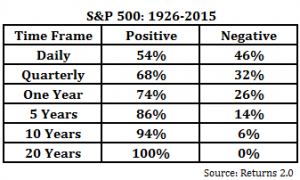Let’s be clear: We did not wish for, nor in any way cause a tumble in the markets, especially among tech stocks. That said, we could not have come up with a more telling illustration to underscore the perennial value of building – and maintaining – a globally diversified investment portfolio for achieving your greatest financial goals.
Global diversification is such a powerful antacid for when (not if!) we experience market turbulence, it’s why we’ve long recommended spreading your market risks:
- According to your personal goals and risk tolerances
- Between stock and bond markets
- Among evidence-based sources of expected long-term returns
- Around the world
In short, broad, global diversification never goes out of style.
Breaking news shows us why.
Just a few short days ago, third quarter market performance numbers were rolling in, and we were fielding questions about the wisdom of continuing to participate in worldwide stock and bond markets. Some globally diversified investors were beginning to question their resolve after comparing their year-to-date returns to the U.S. stock market’s seemingly interminable ability to whistle past the graveyards of disappointing, portfolio-dampening performance found elsewhere.
Some were asking: “Should we dump diversification, and head for the ‘obviously’ greener pastures watered by U.S. stocks?”
We aren’t the only ones advising investors against reacting to hot runs by turning a cold shoulder to their well-structured portfolio. In his timely September 28 column, Wall Street Journal personal finance columnist Jason Zweig commented: “Looking back in time from today, U.S. stocks seem to have dominated over the long run only because they have done so extraordinarily well over the past few years.”
As current conditions starkly show, there’s a reason for the expression, “Things can turn on a dime.” Whether it’s U.S. stocks, international bonds, emerging markets or any other sources of expected return, the evidence is clear: Trends rise and fall among them all. This we know. But precisely when, where, how much, and why is anybody’s guess. As Zweig suggests in his piece, “Markets tend to lose their dominance right around the time it seems most irresistible.”
What’s next?
We’re drafting this message to you Wednesday evening, October 10, in advance of what may be a wild ride for the next little while. By the time you’re reading this, prices may still be tumbling, or they may already have recovered their footing. We can’t say.
Come what may, we hope we can be particularly helpful to you at this time.
Have current conditions left you troubled, unsure of where you stand?
Let’s talk. We’ll explore whether you’re able to sit tight with your existing strategy, or whether we can help you think through any next steps you may be considering. Most of all, know you are not alone! We are here as your sounding board and fiduciary advisor. Your best interests remain our top priority.
Are you reflecting calmly on current events, recognizing that market volatility happens?
Allow us to applaud you for your stamina, and remind you: Current conditions likely represent a time for continued quietude, along with ongoing attention to managing your tailored portfolio.
Regardless of your temperament, we’d like to share a sentiment from Behavior Gap author Carl Richards’ 2015 New York Times column. His point remains as relevant as ever:
“On a scale of 1-10, with 10 being abject misery, I’m willing to bet your unhappiness with a diversified portfolio comes in at about a 5, maybe a 6. But your unhappiness if you guess wrong on your one and only investment for the year? That goes to 11.”
Let’s be in touch if we can answer any questions or scale down any angst you may be experiencing.
Regards,
Your PLC Wealth Team






 2) Capital markets have exhibited an upward trajectory over the long-term, yielding positive, inflation-beating returns to those who have stayed put for the ride.
2) Capital markets have exhibited an upward trajectory over the long-term, yielding positive, inflation-beating returns to those who have stayed put for the ride.